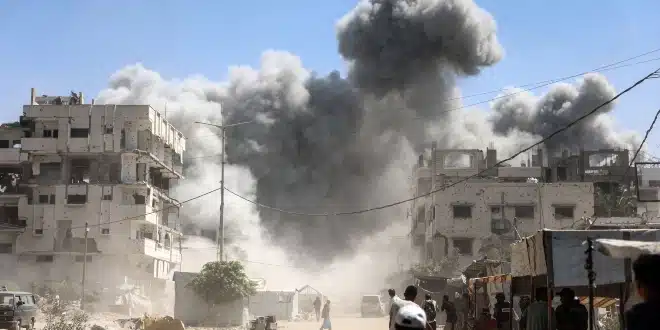The Israeli military issued a stark warning on Friday, declaring it would use “unprecedented force” in Gaza City and urging residents to evacuate south as its ground assault intensifies on the war-torn enclave’s largest urban hub.
Intensifying Offensive Amid Humanitarian Collapse
Nearly two years into the conflict, Israel has launched a major push to seize Gaza City, battering the area with airstrikes, artillery, and tank fire. The assault comes as the city, once home to more than a million people, struggles under what the United Nations has described as a famine.
The latest military escalation also coincides with growing international pressure. Several Western countries, including France and Britain, are preparing to formally recognize a Palestinian state at a U.N. summit next week, a move expected to deepen diplomatic divides.
Israel began its current ground offensive on Tuesday, repeatedly urging civilians to flee southward. Yet for many Palestinians, the journey has proved impossible—either due to cost, lack of transport, or the presence of vulnerable family members unable to walk long distances.
Mass Displacement and Restricted Evacuation Routes
The Israeli army estimates that about 480,000 people have left Gaza City since late August. Still, roughly half a million remain trapped. On Friday, military spokesperson Avichay Adraee announced the closure of Salah al-Din Road, the main north–south artery through the territory, leaving only the Al-Rashid coastal road open for evacuation.
“From this moment, Salah al-Din Road is closed for southbound travel,” Adraee posted on X, urging residents to “join the hundreds of thousands” who have already fled to designated “humanitarian areas” in the south.
Israel has directed evacuees toward Al-Mawasi, a southern coastal zone it labels safe and equipped with aid and medical facilities. However, the same area has been struck repeatedly by Israeli forces throughout the war, with the military insisting it targets Hamas infrastructure there.
Stories of Exhaustion and Desperation
For those attempting the journey, the ordeal is grueling. Nivin Ahmed, 50, described walking more than 15 kilometers with seven family members after leaving Gaza City. “We were crawling from exhaustion,” she said. “My youngest son cried from fatigue. We took turns dragging a small cart with some of our belongings.”
Others have been stranded. Mona Abdel Karim, 36, said her family had been sleeping on Al-Rashid Street for two nights while waiting for a driver. “We can’t walk on foot—my husband’s parents are elderly and sick, and the children are too weak to walk,” she explained.
AFP footage from the scene showed long lines of families on foot and vehicles stacked with household items, underscoring the scale of the displacement.
Rising Civilian Toll
On Friday, Gaza hospitals reported at least 22 people killed across the territory, including 11 in Gaza City. The Israeli military said its forces had “expanded their activity” in the city and dismantled more than 20 military sites in the previous 24 hours.
But for many residents, the immediate reality is unrelenting bombardment. “Our life has become nothing but explosions and danger,” said Sami Baroud, 35, speaking from western Gaza City. “We have lost everything—our lives, our future, our sense of safety. How can I evacuate when I can’t even afford transportation?”
Diplomatic Fallout and War Context
The offensive has intensified as a U.N. inquiry accused Israel of committing “genocide” in Gaza, naming Prime Minister Benjamin Netanyahu and other senior leaders as responsible for incitement. Israel denounced the findings as “distorted and false.”
At the same time, the United States once again vetoed a U.N. Security Council resolution demanding a ceasefire, shielding Israel from international pressure even as civilian deaths mount.
The war traces back to Hamas’s October 7, 2023 attack on Israel, which killed 1,219 people, most of them civilians. Israel’s subsequent campaign has devastated Gaza, with the territory’s health ministry reporting at least 65,174 deaths, also predominantly civilians. The U.N. has deemed those figures credible.
Outlook
With Gaza City under siege, evacuation routes narrowing, and diplomacy faltering, the humanitarian crisis shows little sign of easing. For many Palestinians still trapped in the city, the choice is stark: remain under relentless bombardment or risk a perilous journey south to areas that have also faced strikes. Meanwhile, the broader geopolitical stakes continue to grow, with upcoming U.N. debates on Palestinian statehood likely to heighten tensions further.


